
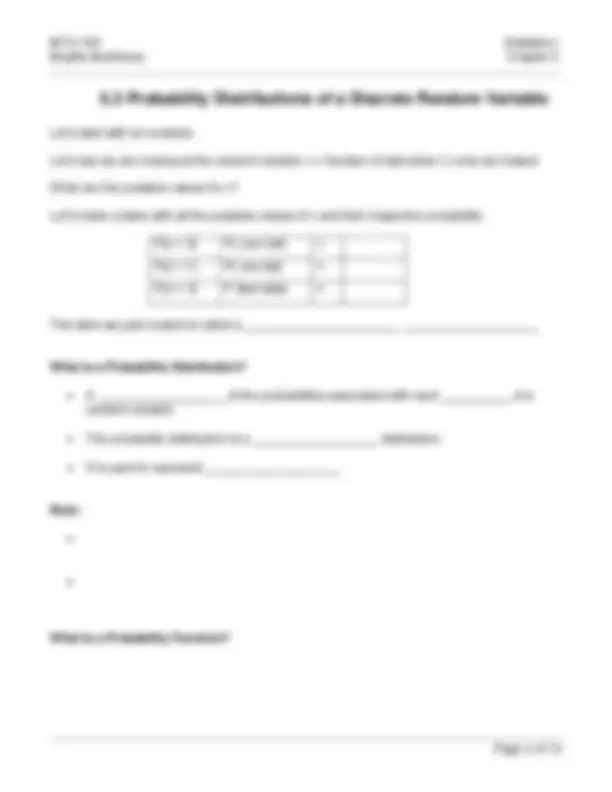
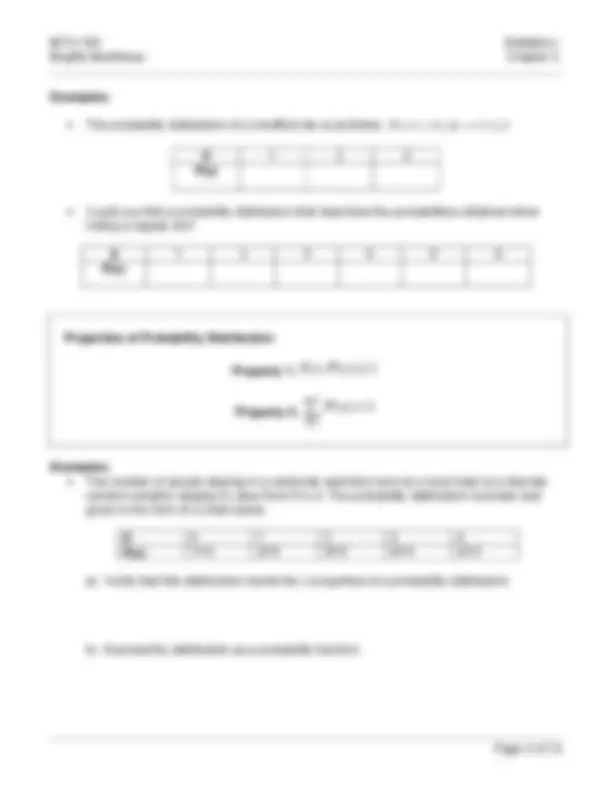
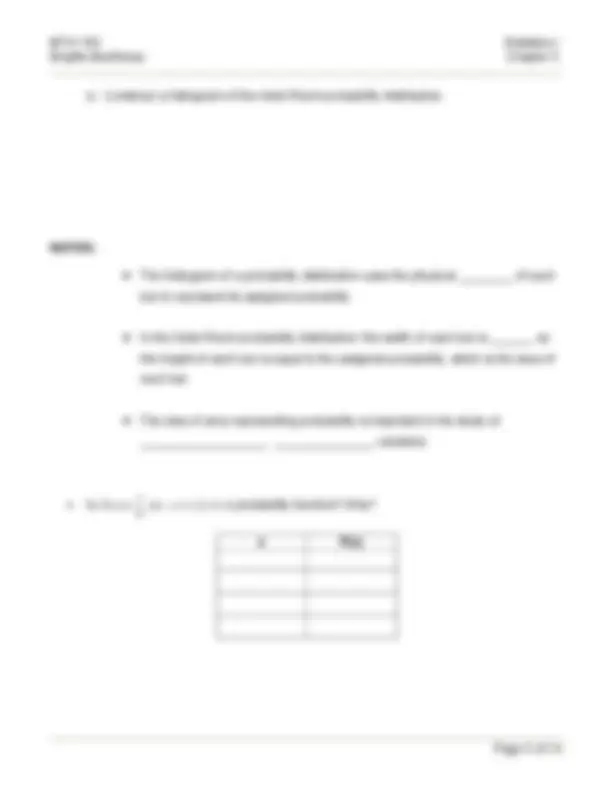
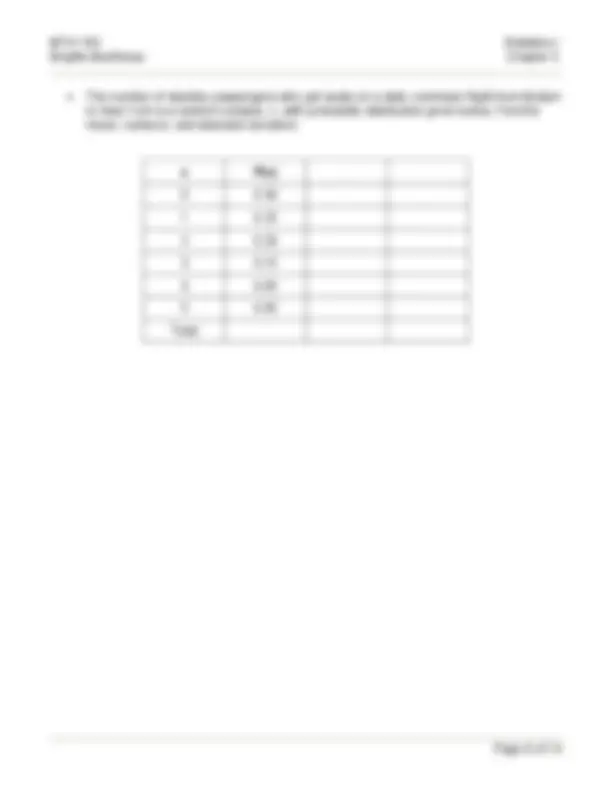
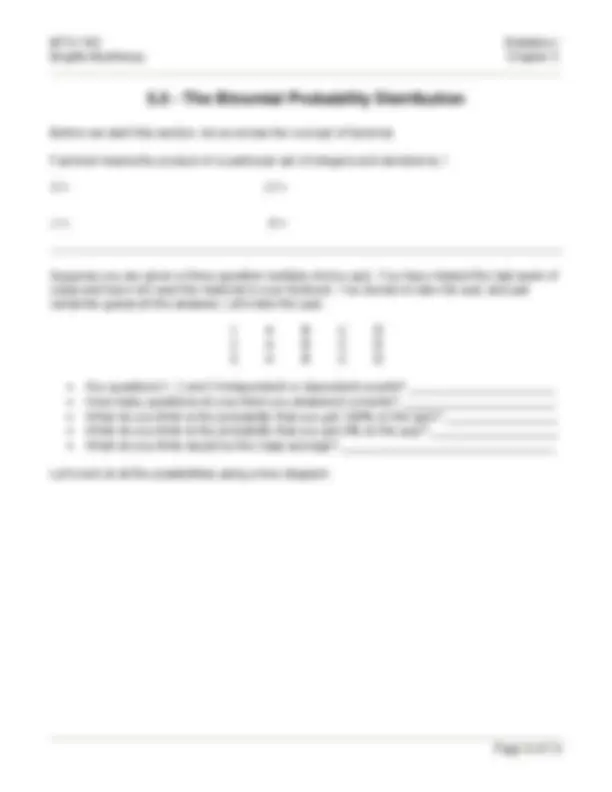
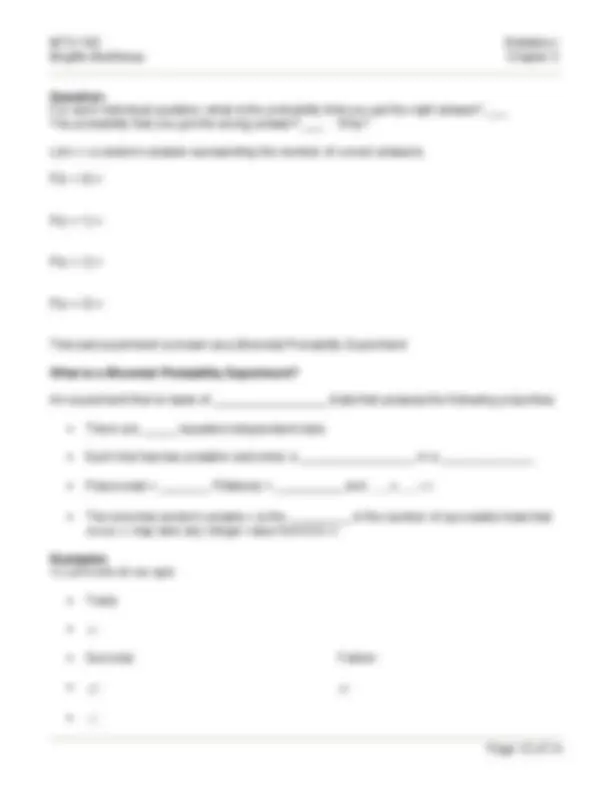
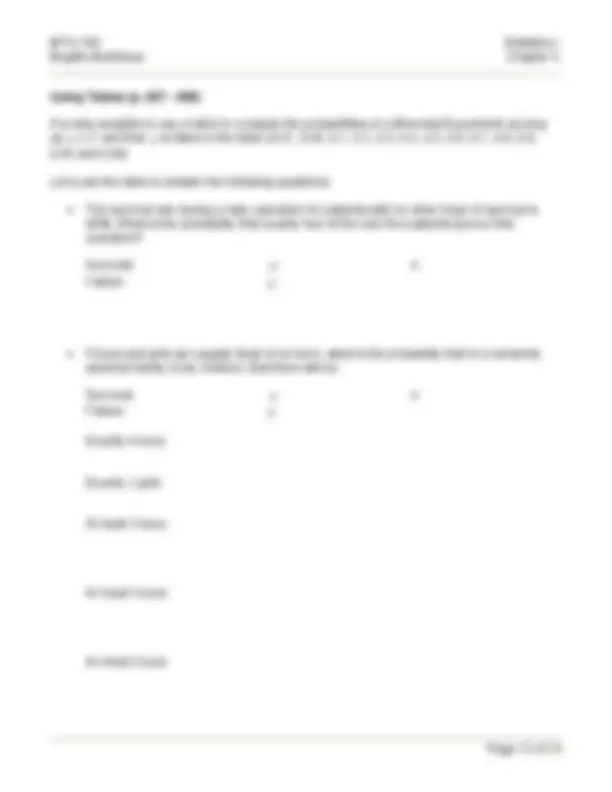
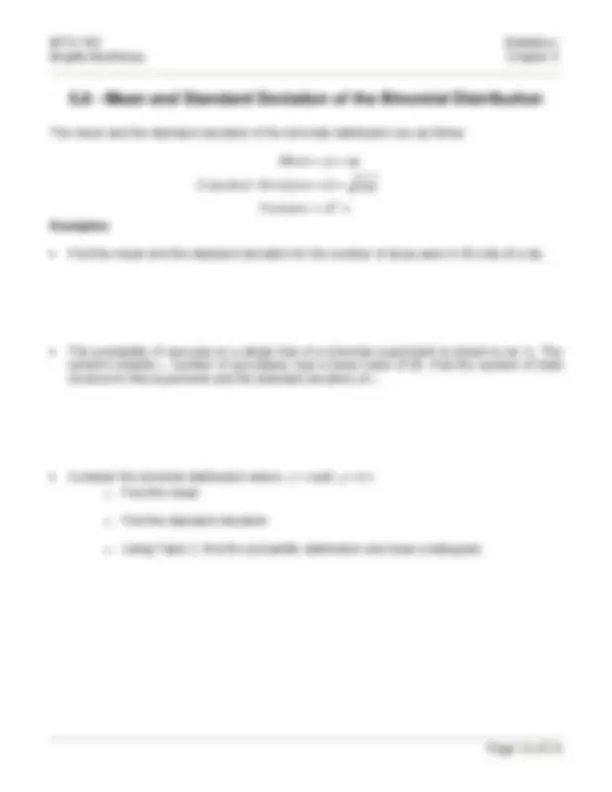


Study with the several resources on Docsity

Earn points by helping other students or get them with a premium plan


Prepare for your exams
Study with the several resources on Docsity

Earn points to download
Earn points by helping other students or get them with a premium plan
Community
Ask the community for help and clear up your study doubts
Discover the best universities in your country according to Docsity users
Free resources
Download our free guides on studying techniques, anxiety management strategies, and thesis advice from Docsity tutors
A chapter extract from 'statistics i' by brigitte martineau, covering the topic of probability distributions of discrete random variables. It explains what random variables are, the concept of probability distributions, and provides examples of discrete probability distributions such as the binomial distribution. The document also discusses the mean and variance of discrete probability distributions.
Typology: Study notes
1 / 14

This page cannot be seen from the preview
Don't miss anything!









5.2 Random Variables
5.3 Probability Distributions of a Discrete Random Variable
5.4 Mean and Variance of a Discrete Probability Distribution
5.5 The Binomial Probability Distribution
5.6 Mean and Standard Deviation of the Binomial Distribution
Brigitte Martineau Chapter 5
Let the number of computers sold per day by a local merchant be a random variable. Integer values ranging from zero to about 50 are possible values.
Let the time it takes an employee to get to work be a random variable. Possible values are 15 minutes to over 2 hours.
Let the volume of water used by a household during a month be a random variable. Amounts range up to several thousand gallons.
Let the number of defective components in a shipment of 1000 be a random variable. Values range from 0 to 1000.
Discrete versus Continuous Random Variables
Discrete Random Variables: A quantitative random variable that can assume a __________________ number of values.
Also known as a ___________________
Continuous Random Variables: A quantitative random variable that can assume an _______________________ number of values. Also known as a ____________________
Brigitte Martineau Chapter 5
Examples:
The probability distribution of a modified die is as follow: P x ( ) x / 6 for x 1, 2,
P(x)
Could you find a probability distribution that describes the probabilities obtained when rolling a regular die?
P(x)
Properties of Probability Distribution
all x
P x^
Examples: The number of people staying in a randomly selected room at a local hotel is a discrete random variable ranging in value from 0 to 4. The probability distribution is known and given in the form of a chart below.
X 0 1 2 3 4 P(x) 1/15^ 2/15^ 3/15^ 4/15^ 5/
a) Verify that this distribution meets the 2 properties of a probability distribution.
b) Express the distribution as a probability function.
Brigitte Martineau Chapter 5
c) Construct a histogram of the Hotel Room probability distribution.
The histogram of a probability distribution uses the physical ________ of each bar to represent its assigned probability
In the Hotel Room probability distribution: the width of each bar is ______, so the height of each bar is equal to the assigned probability, which is the area of each bar.
The idea of area representing probability is important in the study of ___________________ _______________ variables
Is ( ) 1, 2,3, 4 9
x P x for x a probability function? Why?
x P(x)
Brigitte Martineau Chapter 5
The variance, 2 , of a discrete random variable x is found by _________________ each
_____________ all the products together.
2 2
2 2
2 2
The Standard Deviation of a Discrete Random Variable
2
Examples:
Find the mean, the variance and the standard deviation of the following probability
distribution: ( ) 1 2 3
x P x for x and
Brigitte Martineau Chapter 5
The number of standby passengers who get seats on a daily commuter flight from Boston to New York is a random variable, x, with probability distribution given below. Find the mean, variance, and standard deviation.
x P(x)
0 0.
1 0.
2 0.
3 0.
4 0.
5 0.
Total
Brigitte Martineau Chapter 5
Question: For each individual question, what is the probability that you got the right answer? ___ The probability that you got the wrong answer? ___ Why?
Let x = a random variable representing the number of correct answers.
P(x = 0) =
P(x = 1) =
P(x = 2) =
P(x = 3) =
This last experiment is known as a Binomial Probability Experiment
What is a Binomial Probability Experiment?
An experiment that is made of _________________ trials that possess the following properties:
There are _____ repeated independent trials
Each trial has two possible outcomes: a _________________ or a ______________
P(success) = _______, P(failure) = __________ and ___ ___ 1
The binomial random variable x is the _________ of the number of successful trials that occur; x may take any integer value from 0 to n.
Examples
Trials
n :
Success: Failure:
p : q :
x :
Brigitte Martineau Chapter 5
Trials
n :
Success: Failure:
p : q :
x :
The Binomial Probability Function
( ) (^) , 0,1, 2,3,...
What is
n x
What is p x?
What is q n^ x^?
Brigitte Martineau Chapter 5
Using Tables (p. 807 - 809)
It is also possible to use a table to compute the probabilities of a Binomial Experiment as long as n 15 and that p is listed in the table (0.01, 0.05, 0.1, 0.2, 0.3, 0.4, 0.5, 0.6, 0.7, 0.8, 0.9,
0.95 and 0.99)
Let’s use the table to answer the following questions:
The survival rate during a risky operation for patients with no other hope of survival is 80%. What is the probability that exactly four of the next five patients survive this operation?
Success: p : n : Failure: q :
If boys and girls are equally likely to be born, what is the probability that in a randomly selected family of six children, that there will be:
Success: p : n : Failure: q :
Exactly 4 boys
Exactly 2 girls
At least 3 boys
At most 2 boys
At most 5 boys
Brigitte Martineau Chapter 5
The mean and the standard deviation of the binomial distribution are as follow:
2
Examples:
Find the mean and the standard deviation for the number of sixes seen in 50 rolls of a die.
The probability of success on a single trial of a binomial experiment is known to be ¼. The random variable x , number of successes, has a mean value of 80. Find the number of trials involved in this experiment and the standard deviation of x.
Consider the binomial distribution where n 4 and p 0.
o Find the mean
o Find the standard deviation
o Using Table 2, find the probability distribution and draw a histogram.